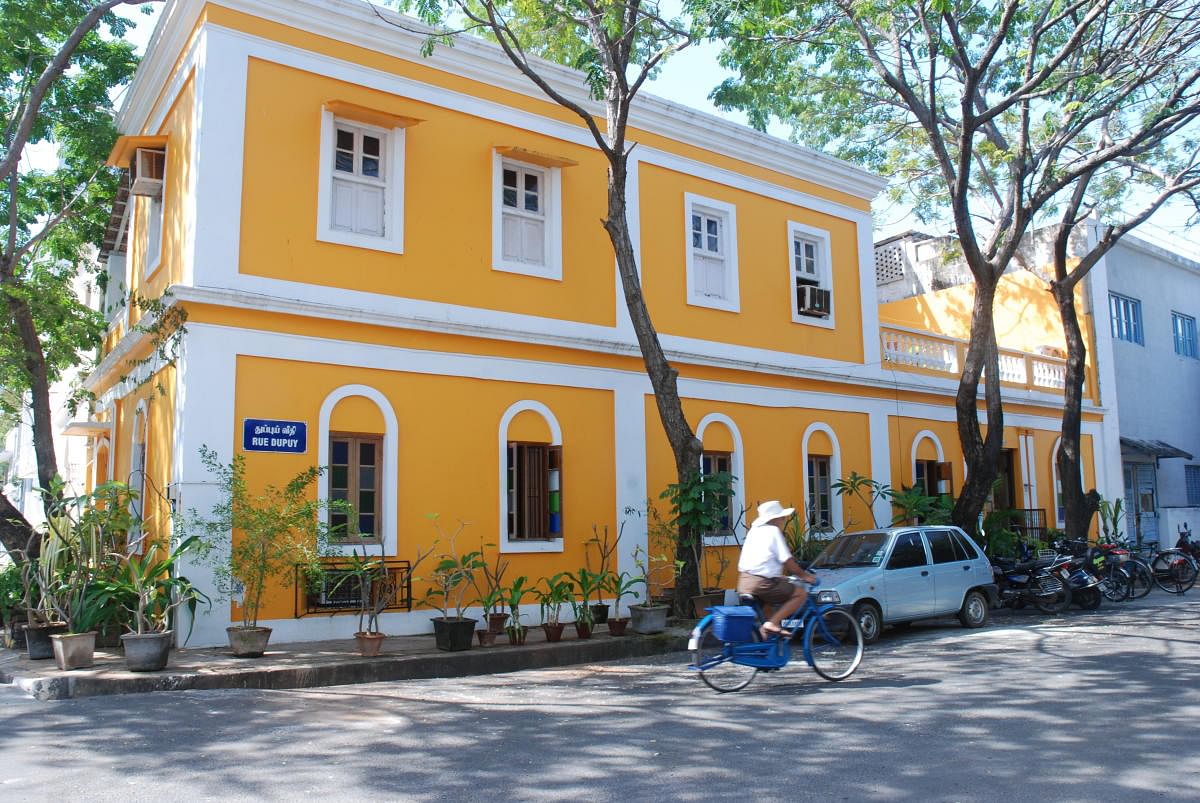
Rambling down the streets of Puducherry, I could see myriad signs of its French colonial heritage: neatly spaced out, geometrically parallel streets, yellow and white houses with tall shuttered windows, richly ornamented Catholic churches, policemen in distinctive red kepis (French military cap with horizontal peak) and elegant mansions with colonnaded balconies, high garden walls adorned by elaborate archways overflowing with bright bougainvillea.
Indeed, with its seafront promenade, enduring pockets of French culture and architecture, and even statues of French saint Joan of Arc and former governor-general (Joseph François) Dupleix, the quaint French outpost exudes an inimitable aura of Gallic chic juxtaposed with Indian spiritual serenity. Streets with French names like Rue des Bassyins de Richemont, Rue St Louis, and Rue Brellecombe snuggle alongside Muthumariamman Koil Street, Chettiar Street, or, for that matter, Sri Aurobindo Street.
Wandering around the French Quarter, I saw some children playing the traditional French game of petanque, a game similar to English lawn bowling. The French presence is also discernible in the several Catholic places of worship that dot the city. The crimson-and-white Sacred Heart of Jesus Christ Church on South Boulevard is striking with its Gothic spires and stained-glass windows on the sides. Equally impressive is the elegant Romanesque Church of Our Lady of the Angels with carved statues in its cream-coloured niches and an oil painting of Our Lady in the altar presented by Napoleon III. The Church of Our Lady of the Immaculate Conception has an imposing façade with columns. Besides churches, there are temples built by the Chola kings between the 10th and 12th centuries. At the Manakula Vinayagar Temple, on Rue d’Orleans (Manakkula Vinayagar Koil Street) in the French Quarter, we saw devotees seeking divine blessings.
A harmonious blend
Puducherry is where French elegance meets Indian exotica. It has two distinct parts: the French Quarter has structures in the European classical style, whereas the buildings in the Tamil Quarter are in the vernacular style of Tamil Nadu.
The two styles have influenced each other with the result that many buildings in both parts of the town are a harmonious blend of European and Tamil architectural patterns. There are a few traditional houses still left untouched. Amid it is the 1873 Mansion of Ananda Rangapillai, a unique specimen of Franco-Tamil architecture.
The French-inspired houses have street frontage with a private inner courtyard that is enclosed. Most of the houses overlook this cobbled courtyard. The façade of the house flaunts projecting balconies that have vertical balustrades, horizontal cornices, and corbels while interiors are spartan with high ceiling, louvered windows, and arched doorways. The two-storeyed houses have winding vaulted staircases.
The Tamil Quarter
My heritage sojourn led me to the streets of Vysial Street, a popular Franco-Tamil architectural streetscape beyond the Grand Canal in the Tamil Quarter of Puducherry. Some houses sport a fusion of the French architectural style and Tamil heritage living. The Tamil-inspired houses, sport continuous wall-to-wall construction, mutram (pillared inner courtyard), thalavaram (street verandah), providing shelter for the pedestrians, and a thinnai (masonry bench) for visitors and pilgrims while the first floor displays French influence.
The inimitable French ambience is perceptible in the protruding, wrought-iron balcony, high ceiling, louvered windows, and arched doorways.
The ‘talking streets’ come alive in the evening when the residents congregate in their thinnais and indulge in their interactive community bonding, recapitulating the day’s events, and discussing all their pet topics, from politics, cinema, and Corona statistics.
As we returned to our hotel, we could feel the lingering camaraderie of these simple folks, inhabitants of a city of many fascinating layers.